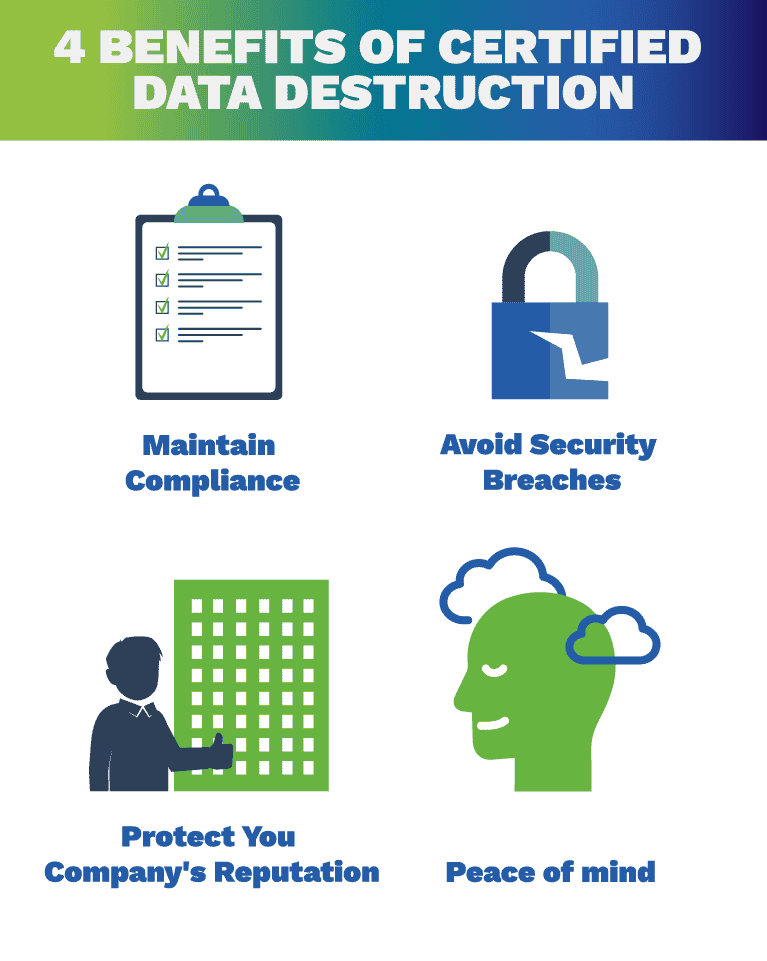Maximizing Cyber Security through Advanced Data Destruction Methods
Maximizing Cyber Security through Advanced Data Destruction Methods
Blog Article
Exploring the Significance of Data Damage in the Context of Computer Protection Providers and Protecting Confidential Information
In a period where data breaches are progressively usual, the relevance of efficient information destruction can not be overstated. What techniques can companies carry out to boost their information damage procedures?
Recognizing Information Devastation
Data damage is a critical component of computer system safety and security that includes the irreversible elimination of data from storage space devices to stop unapproved gain access to and possible data violations. In a significantly electronic landscape, companies face increased dangers connected with sensitive info being incorrectly accessed or manipulated. Reliable data damage safeguards versus these hazards, making sure that personal dataâEUR" such as consumer details, copyright, and monetary recordsâEUR" can not be recouped after disposal.
Comprehending the importance of information destruction expands beyond plain compliance with lawful and governing structures; it is important for preserving organizational integrity and trust fund. When data is improperly managed or improperly damaged, the effects can be serious, including financial loss, reputational damages, and lawful responsibilities.

Methods of Data Eradication

One common technique is information wiping, which includes overwriting existing data with random patterns several times. This method makes the original information irretrievable, making it a popular choice for organizations seeking to protect confidential information.
One more approach is degaussing, which makes use of an effective magnetic area to interrupt the magnetic domain names on storage devices, successfully removing the data. This method is particularly effective for magnetic media but is not applicable to solid-state drives.
Physical damage is another durable approach, crushing or involving the shredding of storage tools. This technique assurances that data recuperation is basically difficult, making it optimal for extremely sensitive information.
Finally, file encryption can serve as a corresponding strategy to information eradication. By securing data before removal, organizations can include an extra layer of safety, making certain that even if residues are recuperated, they continue to be hard to reach without the decryption secret. Each method must be chosen based upon the level of data sensitivity and the certain safety and security needs of the organization.
Legal Conformity and Data Protection
Organizations must browse a complicated landscape of lawful requirements connected to data protection, especially after applying approaches of information removal. Numerous policies, such as the General Data Security Regulation (GDPR) and the Health And Wellness Insurance Mobility and Accountability Act (HIPAA), enforce strict guidelines on how companies need to dispose and handle of delicate data. Failing to follow these regulations can bring about significant legal effects, consisting of substantial fines and reputational damage.
Information damage best site procedures have to be carefully documented to demonstrate conformity with appropriate regulations and standards. This documentation not only functions as proof of adherence to legal responsibilities yet also illustrates a commitment to protecting sensitive info. Organizations must also develop clear plans pertaining to information retention and destruction timelines, ensuring that data is not held longer than required.

Furthermore, normal audits and assessments of information damage methods are vital to keep compliance and adapt to evolving lawful frameworks (data destruction). By proactively dealing with legal demands, organizations can mitigate threats related to data violations and show their commitment to data safety and security. Eventually, focusing on legal conformity in data devastation procedures is not simply a regulative obligation, yet a fundamental facet of a robust information protection method
Effect on Business Online Reputation
The track record of a business can be dramatically affected by its approach to information destruction and administration. In today's digital landscape, where data violations can happen at any minute, the failure to properly deal with delicate details can result in extreme repercussions. Organizations that inadequately handle information damage threat exposing personal customer info, which not only violates privacy legislations but also deteriorates trust amongst stakeholders and customers.
A tarnished track record can cause decreased client commitment, as clients come to be hesitant to engage with a company that has actually shown neglect in shielding their data. Negative attention surrounding a data breach can have a long lasting effect, as prospective clients may be prevented by the regarded absence of security. This can lead to a direct decline in revenue and market share.
Moreover, companies that focus on information devastation as component of their protection approach can boost their reputation by showcasing their dedication to guarding sensitive information. By taking on rigorous information administration methods, organizations can not important link just mitigate threats yet additionally place themselves as credible entities in their respective industries, therefore strengthening their total brand name picture.

Best Practices for Secure Disposal
Carrying out finest practices for safe and secure disposal of data is essential for minimizing dangers related to information breaches and making certain compliance with personal privacy guidelines. Organizations should embrace an extensive information disposal plan that details procedures for both digital and physical data devastation.
For physical data storage space devices, such as hard disk drives, shredding or degaussing is suggested to stop information recuperation. Furthermore, companies should preserve a chain of custodianship paperwork throughout the disposal process, making sure accountability and traceability of disposed products.
For digital data, making use of software that sticks to market requirements for data wiping is essential. This software must overwrite existing information numerous times, making healing virtually impossible. It is likewise crucial to validate the effectiveness of the information destruction procedure with audits or third-party analyses.
Educating staff members on secure disposal methods includes an additional layer of safety and security, as human mistake can usually lead to data exposure. Consistently reviewing and upgrading disposal policies guarantees positioning with progressing guidelines and technical innovations. By implementing these finest methods, organizations can substantially minimize the danger of unauthorized data access and enhance their general data protection strategy.
Conclusion
In conclusion, data devastation is a basic aspect of computer system safety and security services that ensures the defense of secret information from unauthorized access. Implementing efficient techniques of data eradication, sticking to lawful conformity, and acknowledging the effect on organization track record are crucial parts of an extensive information security method. By embracing finest practices for secure disposal, companies can promote trust with customers and protect delicate information, inevitably adding to an extra safe and secure digital landscape.
In an age where information breaches are significantly usual, the significance of efficient data devastation can not be overemphasized.Data devastation is an essential element of computer system safety and security that entails the long-term removal of data from storage space gadgets to protect against unauthorized accessibility and potential information violations. Organizations ought to additionally develop clear plans regarding data retention and devastation timelines, guaranteeing that information is not held longer than necessary.
By proactively attending to lawful needs, organizations can alleviate threats associated with data violations and show their commitment to data safety (data destruction). Ultimately, prioritizing lawful conformity in information destruction processes is not simply a governing obligation, however a basic aspect more tips here of a robust data safety approach
Report this page